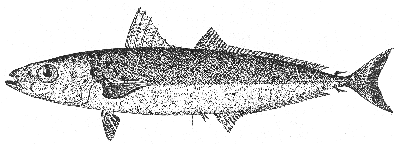Mackerel scad Decapterus macarellus (Cuvier and Valenciennes) 1833
[Jordan and Evermann, 1896-1900, p. 909.]

Figure 199.—Mackerel scad (Decapterus macarellus), Woods Hole. After Goode. Drawing by H. L. Todd.
Description—
This scad is easily recognized among such of its tribe as are known from our Gulf by the presence of a small detached finlet between the second dorsal and the base of the caudal fin with another similar to it behind the anal.[58] Furthermore, it is more slender than most of the other pompanos; its body is only about, one-fifth as deep as it is long, and fusiform like the mackerel. But the great length of the second dorsal fin and the fact that there is only one dorsal finlet and one anal finlet would separate a mackerel scad from a mackerel at a glance. The mouth of the scad is smaller, and its premaxillary bones are protractile. Its triangular first dorsal fin (8 spines) originates over the middle of the pectorals. Its second dorsal (about 34 rays) is [page 375] separated from the first dorsal only by a very short space and extends back nearly to the base of the caudal. Its anal fin is similar to its second dorsal in shape but is shorter (about 28 rays), originates about under the seventh or eighth ray of the second dorsal, and is preceded by 2 short stout spines. The ventrals are shorter than the pectorals and situated under them.
The tail of the scad is less deeply forked than in most of the pompanos. In place of fleshy keels on the caudal peduncle, the rear half of its lateral line is armed with a series of 31 keeled shields, largest on the peduncle, and all of them much larger than the ordinary scales, a very noticeable character.
Color—
Described as slate blue or leaden above, silvery below, with a small black spot on the margin of the gill cover and with the axil of the pectoral black. We have not seen it alive.
Size—
Maximum length about 1 foot.
General range—
Warm parts of the Atlantic, rarely straying northward to the Gulf of Maine and to Nova Scotia.
Occurrence in the Gulf of Maine—
A specimen caught with smelt in Casco Bay, Maine, in October 1920, and another, 7 inches long, taken in a trap at Richmond Island, off Cape Elizabeth in September 1931, are the only Gulf of Maine records, though it has been taken at Canso and at Port Mouton Bay, Nova Scotia.[63] But being common in the autumn about Woods Hole, where as many as 10 barrels have been taken from one trap haul, it would not be surprising to find it north of Cape Cod any summer.
[58] A second scad, the round robin (Decapterus punctatus), similarly characterized, is known as far north as the Woods Hole region. It has 40 or more scutes or shieldlike scales along the lateral line, instead of only about 30 or 31; Its jaws are toothed, and it is spotted along the lateral line, characters that separate it from the mackerel scad.
[63] This last fish, a 2½-inch specimen, caught October 10, 1928, was recorded by Leim (Proc. Nova Scotian Inst. Sci., vol. 17, No. 4, 1930, p. xlvi).